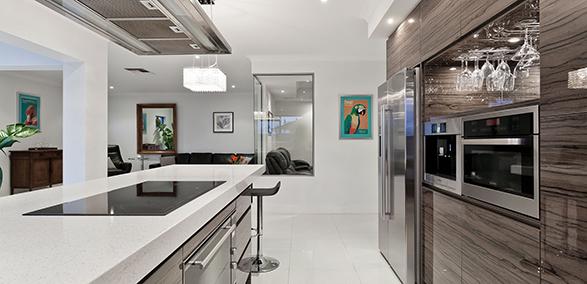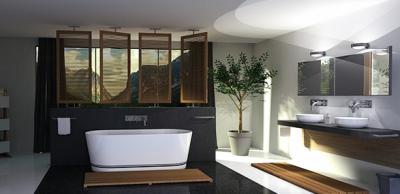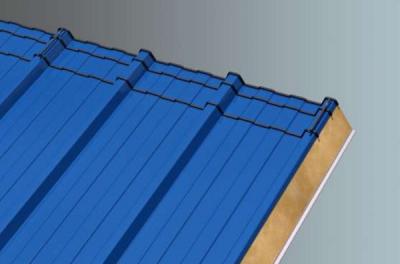When does a replacement kitchen or bathroom need building regulations approval?
The majority of domestic like for like replacement kitchens or bathrooms won't need any form of building regulations approval, but if you're modifying the existing layout then approval may be needed.
This might be due to (from the Building Regulations):
"3(b) the provision or extension of a controlled service or fitting in or in connection with a building;
3(c) the material alteration of a building, or a controlled service or fitting;
3(d) work required by regulation 6 (requirements relating to material change of use);"
A "controlled service or fitting" means;
"A service or fitting in relation to which Part G (Sanitation, hot water safety & water efficiency), H (Drainage & Waste Disposal), J (Combustion appliances & fuel storage systems), L (Conservation of fuel & power) or P (Electrical safety) of Schedule 1 imposes a requirement."
"None of the work, or any part of it, should at any stage result in not complying with or being more unsatisfactory with a relevant requirement where previously it did."
Confused?!
So what does it mean and just how is it relevant to replacement kitchens and bathrooms?
Are you undertaking the provision or extension of a controlled service or fitting? |
Does this require building regulations approval? |
| If you move the boiler to another location. | Yes (see Approved Document J in England and Wales) |
| If you leave the boiler where it is but extend the flue. | Yes (see Approved Document J in England and Wales) |
| If you install a new gas appliance. | Yes (see Approved Document J in England and Wales) |
| If you relocate the sink. | Yes, if the installation of the fitting or fittings will involve alterations to, or new connections to, a drainage stack or an underground drain, the above ground wastes and drains are controllable (see Approved Document H in England and Wales). So is the installation of hot water and wholesome water to the sink (see Approved Document G in England and Wales). |
| If you relocate the bathroom appliances. | Yes, if the installation of the fitting or fittings will involve alterations to, or new connections to, a drainage stack or an underground drain, the above ground wastes and drains are controllable (see Approved Document H in England and Wales). So is the installation of hot water and wholesome water to the bath, shower, wash basin and bidet. (see Approved Document G in England and Wales). |
| If you replace a window or external door. | Yes, this is a renovation of a thermal element (see Approved Document L1 in England and Wales). |
| If you install a new window or external door. | Yes (see Approved Document L1 in England and Wales). |
| If you install an electrical circuit. | Yes (see Approved Document P in England and Wales). |
| If you install or alter fixed electrical equipment in rooms containing a bath or a shower. | Yes, if the circuit is within the 'special location' measured 2.25m vertically from the floor or shower head (if higher) and within 600mm of any bath tub or shower tray (see Approved Document P in England). |
| If you install or alter fixed electrical equipment in the kitchen. |
In England, this is typically non-notifiable work unless a new circuit is provided e.g. installing a new built-in cooker or prefabricated modular lighting is non-notifiable unless a new circuit is required. The work still falls within the scope of Part P and should be certificated in accordance with BS7671 and local authorities can still take enforcement action if they consider the work non-compliant and unsafe. (see Approved Document P in England). In Wales, this work is typically notifiable. Notifiable jobs include new circuits back to the consumer unit, and |
| If you install an extract fan. | Yes, if it requires a new electrical circuit, the extract should go to outside where possible (see Approved Document P in England and Wales). |
Are you carrying out a material alteration?
Removing load bearing walls to accommodate a new layout is a structural alteration. Design and fire resistance will be needed for the new lintel, bearings and foundations may need to be examined for suitability.
Removing doors (or non-load bearing walls) between the kitchen and other rooms, particularly to a staircase, will affect means of escape (Requirement B1 of the Building Regulations). Additional precautions in other parts of the property may be needed such as escape windows, interlinked smoke and heat detection, and additional fire resistance (Requirement B3 of the Building Regulations). Alternatively you may need to retain the door(s) so it is no worse than before.
Are you carrying out a material change of use?
This classification involves the creation of a dwelling, subdivision to create more than one dwelling or flat or room for residential purposes. The installation of a second kitchen would indicate this likely use and building regulations approval would be required and possibly planning permission.
Could alterations alter the status of a building?
Other than change of use (above), a request may also be received to install a kitchen in a conservatory. Some conservatories are exempt from the requirement for a building regulations application. However, undertaking works to an exempt conservatory, such as removing the external doors or the opening is widened to open it up to the main house, will likely remove the exemption status enjoyed by the conservatory and approval is needed
If that happens, it reverts to an extension of the main house and thermal compliance will be difficult to achieve because of the excessive glazing. An open kitchen/dining space is a popular alteration to properties and care is needed to ensure compliance is possible.
If your building is listed in some way, for its architectural or historic interest and/or is located in a sensitive urban or rural environment (e.g. a conservation area or an area of outstanding natural beauty), then alterations may require additional consent from the planning department.
Remember the reference "Not complying with or being more unsatisfactory with a relevant requirement where previously it did"? This means that the works must not make fabric, services and fittings less compliant than they previously were – or dangerous.
For example, the provision of replacement double glazing must not worsen compliance in relation to: means of escape; air supply for combustion appliances and their flues; and ventilation for health.
Electrical installations must not worsen compliance in relation to:
- structure (depth of chases in walls, notches in floor and roof joists)
- fire safety (provision of detection systems, fire resistance of penetrations through floors and walls)
- site preparation (resistance of service penetrations to rainwater and radon)
- sound (service penetrations on party walls)
- ventilation
- thermal (use of energy efficient lighting)
- access (heights of sockets and switches)
If you're in any doubt then speak to your Principal Designer and/or Principal Contractor who can offer advice and guidance on how to comply.
Find your local authority's contact details here
Further information
Homeowners, find out much more about how the building regulations apply to your other projects such as:
Please Note: Every care was taken to ensure the information was correct at the time of publication. Any written guidance provided does not replace the user’s professional judgement. It is the responsibility of the dutyholder or person carrying out the work to ensure compliance with relevant building regulations or applicable technical standards.
This article was updated on August 2024
Sign up to the building bulletin newsletter
Over 48,000 construction professionals have already signed up for the LABC Building Bulletin.
Join them and receive useful tips, practical technical information and industry news by email once every 6 weeks.
Subscribe to the Building Bulletin




Comments
Webmaster note
Submitted 7 years 3 months ago
(No subject)
Submitted 7 years 3 months ago
(No subject)
Submitted 7 years 3 months ago
The position of an electric hob isn't usually controlled under the Building Regulations.
There are some exceptions in relation to locating a cooking appliance away from the entrance door in certain open plan flat layouts.
Also, any new electrics in the kitchen will need a Part P electrical certificate from a competent person.
Thanks,
John, LABC
Adding a shower to a bathroom
Submitted 7 years 2 months ago
I want to renovate my bathroom. At the moment the bathroom contains a bath and wash basin only. I want to change this to a bath, separate shower and wash basin.
The property is a raised ground floor flat, above an unused basement area, and the waste pipes go down through the floor and then exit through the wall.
So the shower waste could feed into the bath and wash basin waste pipes, as these go downwards.
The position of the bath and wash basin may also change (within the same room), I haven't decided on the final layout yet.
I am also installing a combi boiler and gas central heating (previously hot water was via an immersion heater) so changing the pipework.
Do I need building reg approval for the shower, or if I alter the position of the existing bath and wasbasin within the same room.
Reply
Submitted 7 years 2 months ago
Thanks for your message.
A Building Regulation application will be required for the new sanitary fittings and the drainage from them. If they were being swapped like for like in the same positions, an application wouldn't be required.
Replacement boilers are also controlled under the Building Regulations. The vast majority are undertaken by competent persons on the Gas Safe Register. They send notification of the completed installation to Building Control within 30 days of completion.
Thanks,
John, LABC
Kitchen
Submitted 7 years 2 months ago
At present the water supply and waste pipes run to and from the kitchen.
I would like to change the kitchen to a utility/ laundry room with sink, washing machine and tumble drier, and airing cupboard and ironing area.
The living room is next to the existing kitchen. I would like to have an open plan kitchen in this living room. There would be a sink, kitchen cupboard units, and cooker on the wall adjoining the existing kitchen. The sink water supply would come from the existing kitchen and the waste pipes would drain out through the existing kitchen waste pipes.
On another wall there would be more kitchen cupboard units and a fridge.
Do I need building reg approval for this work
Reply
Submitted 7 years 2 months ago
A building regulation application will be required for the new drainage from the appliances in the utility and for the new kitchen sink. It's also required for new mechanical ventilation to the utility room and new kitchen. It isn't required for items like kitchen cupboards.
Regards,
John, LABC
Moving of cellar
Submitted 7 years 2 months ago
I moved my kitchen units up from what was a basement kitchen after a flood down there. I put a couple of units in the living room to make it a kitchen/lounge. In the cellar I fitted a saniflow and a sump pump. Should I have applied to building regulations first? The work was all approved by the council (I got a post-2015-flood grant from them to do it) so I didn't think I would. But I'm selling now and I'm not so sure.
Reply
Submitted 7 years 2 months ago
Moving kitchen units won't require a Building Regulation application. If the sink or the cooker was moved this work would be controllable under the Building Regulations. Similarly the new drainage to the cellar would require a Building Regulation application. If the work has been completed you may wish to apply for a regularisation certificate from your local building control office.
Regards,
John, LABC
(No subject)
Submitted 7 years ago
Add new comment